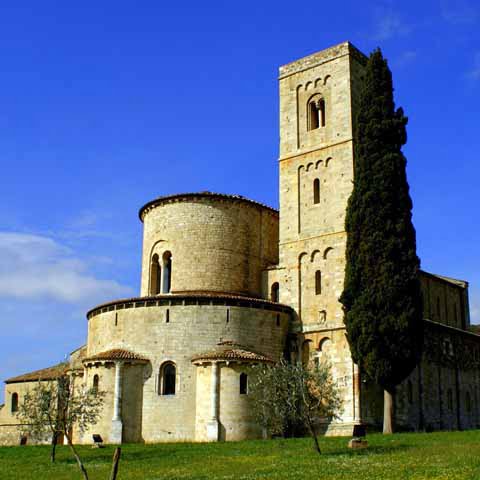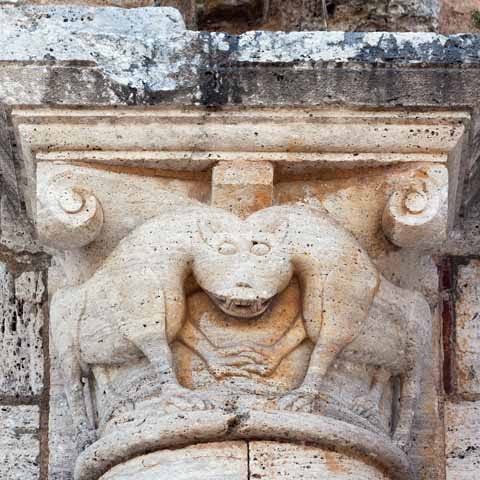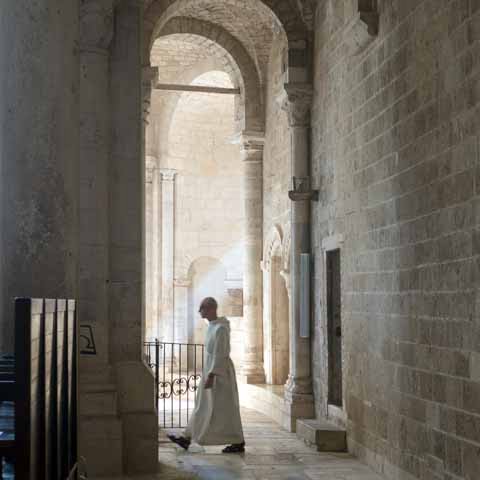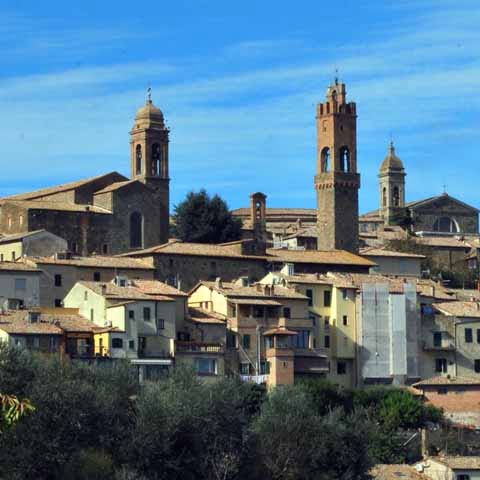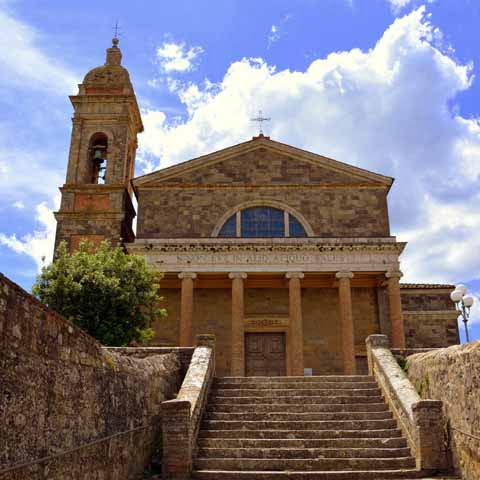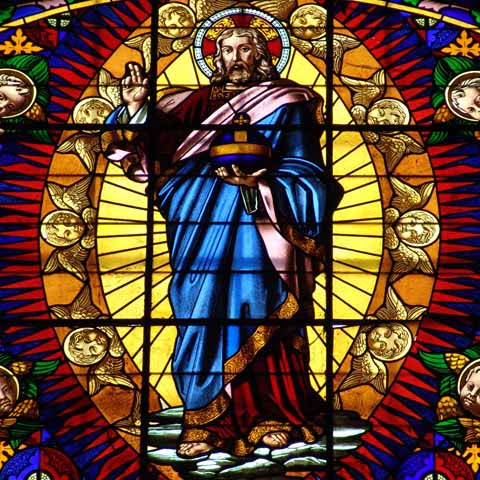The hilltop town of Montalcino situated in the Tuscan countryside is renowned for its scenery and beloved Brunello di Montalcino wine. The town is located in the picturesque Val d’Orcia area of Tuscany that features iconic rolling hills and verdant cypress trees. The center of town is characterized by medieval structures, such as the imposing defensive fortress. The nearby Abbey of Sant’Antimo is a well-preserved marvel of medieval architecture.
Part of the province of Siena, Montalcino offers visitors the quintessential elements of Tuscan culture: jaw-dropping panoramas, flavorful local cuisine, historic architecture, and high-quality wine. For these reasons, the town has become a favorite among visitors to Tuscany.
PREHISTORY OF MONTALCINO
Traces of prehistoric settlements have been found in the Montalcino countryside, though there is not any evidence of a significant settlement in the area of Montalcino during the time of the Ancient Romans.
HISTORY OF MONTALCINO
The birth of Montalcino can be officially traced back to around the tenth century, although there is a previous document (715), signed by the King of the Lombards, Liutprando, in which the dispute between the Diocese of Siena and that of Arezzo is mentioned for the possession of some existing parish churches in the Montalcino area.
During the early medieval period, the invasions by the barbarians in the hinterland and by the Saracens in the maritime cities prompted the inhabitants of the Tuscany area to seek safer accommodation in the interior of the region.
According to a historical document from 814, a church was built in this area, probably by the monks of the Abbey of Sant’Antimo. Indeed, the document mentions the granting of jurisdiction over Montalcino to the Abbey of Sant’Antimo by Louis the Pious, the King of the Franks and co-emperor with his father, Charlemagne.
Subsequently, the middle of the tenth century was marked by population growth.
During the late Middle Ages, Montalcino enjoyed a certain autonomy and independence, even obtaining the right of free port on the Via Francigena pilgrim route.
Montalcino experienced long periods of peace, in which it prospered and grew, alternated with periods in which it was involved in conflicts between neighboring cities, in particular Siena and Florence.
In 1110, as stronghold of the Republic of Siena, Montalcino was fortified with walls during the war against Orvieto and Montepulciano.
Until the first half of the thirteenth century, Siena and Florence alternated in the domination of this center; in 1211, an agreement was stipulated between the Abbot of Sant’Antimo, the Sienese, and the inhabitants of Montalcino, which provided for the transfer of part of the territory to Siena.
In 1252, when Montalcino was once again free from Sienese domination, the town allied with the Florentines who successfully defended it from a Sienese siege that attempted to retake the town.
The Battle of Montaperti on September 4, 1260 was won by the Tuscan Ghibellines, supporters of the Holy Roman Empire, and a coalition led by Siena against the Florentine Guelph supporters of the Papacy. With this event, Montalcino definitively entered the orbit of Sienese influence.
A century had to pass, however, for the locals to become citizens of the Republic of Siena in all respects (1361) and to obtain tax and tax relief. Siena thus made the place an important defensive stronghold, building the fortress, symbol of the Sienese domination in Montalcino, in just a few years (1361-1363), and considerably reinforcing the defensive walls.
In 1462, Montalcino was elevated to the rank of city and erected to diocese together with Pienza by Pope Pius II, a native of Pienza.
In 1553, the town was attacked by Charles V, Holy Roman Emperor and Archduke of Austria. The city also suffered the siege of the militias allied with the Florentine Medici.
In 1555, Siena, protected by the French, capitulated to the Medici troops. Montalcino held out for some years, founding the Republic of Siena in Montalcino, but in 1559 ultimately fell to the Florentines. In that year, with the Treaty of Cateau Cambrésis, peace was stipulated between France and Spain and their allies; the Republic of Siena, of which Montalcino was part, was definitively annexed to the Grand Duchy of Tuscany, until annexation to the Kingdom of Italy, in 1860.
During the twentieth century, the city felt the impact of the two World Wars. However, the increasing popularity of its wine helped Montalcino to overcome the devastation of the wars.
For the locals, the cultivation of the vine is a centuries-old tradition. The Medici, once they became lords of the city (1559), were the first to appreciate these wines, so much so that they sent them to court in Florence and in Rome to the table of Pope Clement VII. Even in the following centuries traces of the presence of notable wines can be observed; between 1700 and 1800 writers, politicians, and agricultural scholars spoke highly of Montalcino and its delicious nectars.
Today, the wine industry continues to be a great source of wealth for the city as well as a boon for local tourism.
ARCHEOLOGY IN MONTALCINO
The Siena area, which includes the town of Montalcino, is rich with archaeological remains of all kinds; from prehistoric times to the Middle Ages, the traces of ancient civilizations are still clearly perceptible in the landscape, in the toponymy, and in the centuriation of the countryside. Over the centuries, important excavation campaigns have led to the discovery of unique Etruscan and Roman archaeological sites with a myriad of treasures.
In the Montalcino area, there are two important pre-Etruscan archaeological sites worth mentioning. In one of the sites, which is located north of the city, about 200 objects dating back to the Stone Age, such as engraving tools and other objects, have been discovered. The other site is located in the area called “Buca di Sant’Antimo.” Two corpses dating back to the Bronze Age and a vase from the third millennium BC were found in a cave approximately 30 feet deep. The vase is now exhibited at the Archaeological Museum of Florence.
The substantial archaeological heritage of the Montalcino area is preserved at the Civic and Diocesan Museum of Sacred Art of the city. The rooms of the museum include an Archaeological Section, within which visitors can retrace the archaeological history of the area from prehistoric times to the Etruscan period.
Other archeological nearby museums can be found in Castellina in Chianti, Cetona, Chiusi, Chianciano, San Gimignano, Trequanda, and, of course Siena, with its notable collections of prehistory, classical archeology, and medieval archeology.
Don't just see Italy, live it.
Your dream trip to Italy has never been closer
No more endlessly scrolling travel sites. Our travel experts will craft the perfect, one-of-a-kind trip just for you.

300+
DESTINATIONS
We offer more Italian destinations than any travel site. Do and see more with Trips 2 Italy.
1 (of a kind)
ITINERARIES
Because your dream trip to Italy should be designed for you, not for the masses.
100%
PEACE OF MIND
From flights and accommodations, to food and activities - we take care of every detail.
